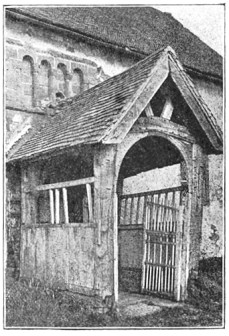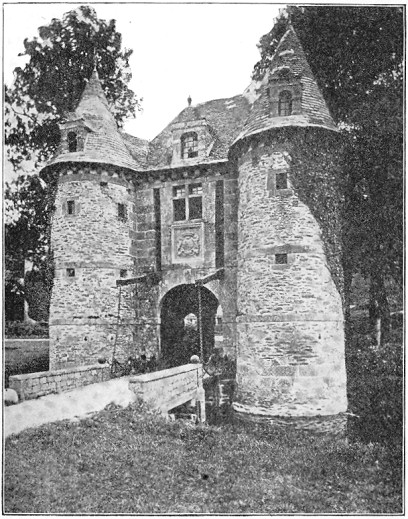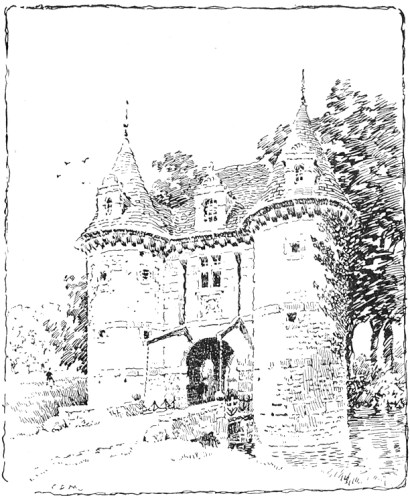I would like to call your attention to a great little old book on pen drawing, mostly architectural subjects, that is a quick read and has some good ideas for the landscape painter. It is
Pen Drawing by Charles Miginnis It can be read in HTML or downloaded for free at the Archive.org site. There are lots of fabulous books in there. Here follows an excerpt from the book that discusses the changes he has made to a drawing from a photograph. The thought process sounds like some of the things that I have written about on design.
--------------------------------------------------------------------------------------------------------
From the book Pen Drawing;
I have thought it advisable in this chapter to select, and to work out in some detail, a few actual problems in illustration, so as to familiarize the student with the practical application of some of the principles previously laid down.
 |
| FIG. 35 | FROM A PHOTOGRAPH |
 |
| FIG. 36 | D. A. GREGG |
First Problem In the first example the photograph, Fig. 35, shows the porch of an old English country church. Let us see how this subject has been interpreted in pen and ink by Mr. D. A. Gregg, Fig. 36. In respect to the lines, the original composition presents nothing essentially unpleasant. Where the strong accent of a picture occurs in the centre, however, it is generally desirable to avoid much emphasis at the edges. For this reason the pen drawing has been "vignetted,"—that is to say, permitted to fade away irregularly at the edges. Regarding the values, it will be seen that there is no absolute white in the photograph. A literal rendering of such low color would, as we saw in the preceding chapter, be out of the question; and so the essential values which directly contribute to the expression of the subject and which are independent of local color or accidental effect have to be sought out. We observe, then, that the principal note of the photograph is made by the dark part of the roof under the porch relieved against the light wall beyond. This is the direct result of light and shade, and is therefore logically adopted as the principal note of Mr. Gregg's sketch also. The wall at this point is made perfectly white to heighten the contrast. To still further increase the light area, the upper part of the porch has been left almost white, the markings suggesting the construction of the weather-beaten timber serving to give it a faint gray tone sufficient to relieve it from the white wall. The low color of the grass, were it rendered literally, would make the drawing too heavy and uninteresting, and this is therefore only suggested in the sketch. The roof of the main building, being equally objectionable on account of its mass of low tone, is similarly treated. Mr. Gregg's excellent handling of the old woodwork of the porch is well worthy of study.
Second Problem Let us take another example. The photograph in Fig. 37 shows a moat-house in Normandy; and, except that the low tones of the foliage are exaggerated by the camera, the conditions are practically those which we would have to consider were we making a sketch on the spot. First of all, then, does the subject, from the point of view at which the photograph is taken, compose well?* It cannot be said that it does. The vertical lines made by the two towers are unpleasantly emphasized by the trees behind them. The tree on the left were much better reduced in height and placed somewhat to the right, so that the top should fill out the awkward angles of the roof formed by the junction of the tower and the main building. The trees on the right might be lowered also, but otherwise permitted to retain their present relation. The growth of ivy on the tower takes an ugly outline, and might be made more interestingly irregular in form.
 |
| FIG. 37 | FROM A PHOTOGRAPH |
The next consideration is the disposition of the values. In the photograph the whites are confined to the roadway of the bridge and the bottom of the tower. This is evidently due, however, to local color rather than to the direction of the light, which strikes the nearer tower from the right, the rest of the walls being in shadow. While the black areas of the picture are large enough to carry a mass of gray without sacrificing the sunny look, such a scheme would be likely to produce a labored effect. Two alternative schemes readily suggest themselves: First, to make the archway the principal dark, the walls light, with a light half-tone for the roof, and a darker effect for the trees on the right. Or, second, to make these trees themselves the principal dark, as suggested by the photograph, allowing them to count against the gray of the roof and the ivy of the tower. This latter scheme is that which has been adopted in the sketch, Fig. 38.
 |
| FIG. 38 | C. D. M. |
It will be noticed that the trees are not nearly so dark as in the photograph. If they were, they would be overpowering in so large an area of white. It was thought better, also, to change the direction of the light, so that the dark ivy, instead of acting contradictorily to the effect, might lend character to the shaded side. The lower portion of the nearer tower was toned in, partly to qualify the vertical line of the tower, which would have been unpleasant if the shading were uniform, and partly to carry the gray around to the entrance. It was thought advisable, also, to cut from the foreground, raising the upper limit of the picture correspondingly. (It is far from my intention, however, to convey the impression that any liberties may be taken with a subject in order to persuade it into a particular scheme of composition; and in this very instance an artistic photographer could probably have discovered a position for his camera which would have obviated the necessity for any change whatever;—a nearer view of the building, for one thing, would have considerably lowered the trees.)
 Red figured war was produced and replaced the earlier black figured ware in about 530 B.C. and was produced until about the 3rd century B.C.
Red figured war was produced and replaced the earlier black figured ware in about 530 B.C. and was produced until about the 3rd century B.C. The applied slip decoration is bone in the negative, leaving the red behind to serve as the image, in the black figured ware the black was applied as the drawing and the red was left as the background color. The advantage of this was that it allowed the painter to work the small details with his brush. In black figure ware they had to be left behind like the whites in a watercolor or scraped into the black with a point.
The applied slip decoration is bone in the negative, leaving the red behind to serve as the image, in the black figured ware the black was applied as the drawing and the red was left as the background color. The advantage of this was that it allowed the painter to work the small details with his brush. In black figure ware they had to be left behind like the whites in a watercolor or scraped into the black with a point. The painting and the aesthetics has developed steadily and during this period it is at its height. Athens was the leading producer of these potteries which were sold through out the Mediterranean world. They were enormously popular and produced in a wide range of qualities. The poor used undecorated crude pottery. The finest sorts were very expensive.
The painting and the aesthetics has developed steadily and during this period it is at its height. Athens was the leading producer of these potteries which were sold through out the Mediterranean world. They were enormously popular and produced in a wide range of qualities. The poor used undecorated crude pottery. The finest sorts were very expensive. In the 18th and early 19th century these vases were affordable, they existed in huge quantities and they were a common bring-home souvenir for elegant tourists to the Greece and Italy. Many of the collections about the world got their start upon the collections of a private party.
In the 18th and early 19th century these vases were affordable, they existed in huge quantities and they were a common bring-home souvenir for elegant tourists to the Greece and Italy. Many of the collections about the world got their start upon the collections of a private party. The drawing and elegant design of the vases is of the highest caliber and they are works of art that equal the art upstairs in the more crowded picture galleries. When the galleries of paintings are too full, I go downstairs and enjoy the fine painting on the Greek vases.
The drawing and elegant design of the vases is of the highest caliber and they are works of art that equal the art upstairs in the more crowded picture galleries. When the galleries of paintings are too full, I go downstairs and enjoy the fine painting on the Greek vases. To those of you who have weathered my posts on classical pottery, thank you for your stamina. My sites stats have dropped like a stone since I started posting on this. I suppose most painters would wonder why they should know about this stuff. I think that the aesthetic sense is trainable and that is done by being acquainted with the art of your culture.
To those of you who have weathered my posts on classical pottery, thank you for your stamina. My sites stats have dropped like a stone since I started posting on this. I suppose most painters would wonder why they should know about this stuff. I think that the aesthetic sense is trainable and that is done by being acquainted with the art of your culture. I have a post to do tomorrow on color temperature and then a couple of responses to reader queries. Then who knows what. But be forewarned, I intend to do the orders of furniture and English 19th century transfer printed pottery before I am done. Gonna have to cover some architecture, and define chriselephantine for you too. See you all tomorrow when I return to the art of making paintings.
I have a post to do tomorrow on color temperature and then a couple of responses to reader queries. Then who knows what. But be forewarned, I intend to do the orders of furniture and English 19th century transfer printed pottery before I am done. Gonna have to cover some architecture, and define chriselephantine for you too. See you all tomorrow when I return to the art of making paintings.















































